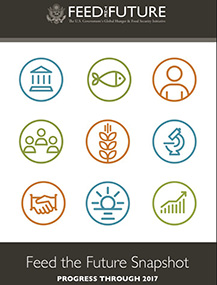- What We Do
- Agriculture and Food Security
- Democracy, Human Rights and Governance
- Economic Growth and Trade
- Education
- Ending Extreme Poverty
- Environment and Global Climate Change
- Gender Equality and Women's Empowerment
- Global Health
- Water and Sanitation
- Working in Crises and Conflict
- U.S. Global Development Lab
Nearly 800 million people across the globe go to bed hungry every night. To meet the needs of a world population expected to reach 9 billion by 2050, agricultural production will need to increase by at least 60 percent.
Given scarcity of resources and other challenges, we will also have to be more efficient in how we meet this demand. Ensuring that people have sufficient food requires aligning short-term assistance with a long-term development strategy to help countries feed their own people.
What is Food Security?
-
Food security means having, at all times, both physical and economic access to sufficient food to meet dietary needs for a productive and healthy life.
-
A family is food secure when its members do not live in hunger or fear of hunger.
-
Food insecurity is often rooted in poverty and has long-term impacts on the ability of families, communities and countries to develop.
-
Prolonged undernourishment stunts growth, slows cognitive development and increases susceptibility to illness.
USAID is advancing global food security by helping to improve the most basic of human conditions: the need that families and individuals have for a reliable source of quality food and sufficient resources to purchase it. This, in turn, supports global stability and prosperity.
Feed the Future is the U.S. Government’s global hunger and food security initiative, which establishes a foundation for lasting progress against global hunger. With a focus on smallholder farmers, particularly women, Feed the Future supports partner countries in developing their agriculture sectors to spur economic growth that increases incomes and reduces hunger, poverty and undernutrition. Feed the Future efforts are driven by country-led priorities and rooted in partnership with governments, donor organizations, the private sector and civil society to enable long-term success.
Led by USAID, Feed the Future draws on the strengths of agencies across the U.S. Government and leverages resources and efforts with multilateral organizations, NGOs, the private sector, research institutions and other stakeholders to accelerate inclusive agricultural growth.
Feed the Future has driven remarkable gains in just a few short years and is growing strong momentum to end global hunger and poverty. Overall, Feed the Future aims to reduce the prevalence of poverty by 20 percent and the prevalence of stunted children under five years of age by 20 percent in the areas where the initiative works.
Visit FeedtheFuture.gov to learn more.










Comment
Make a general inquiry or suggest an improvement.